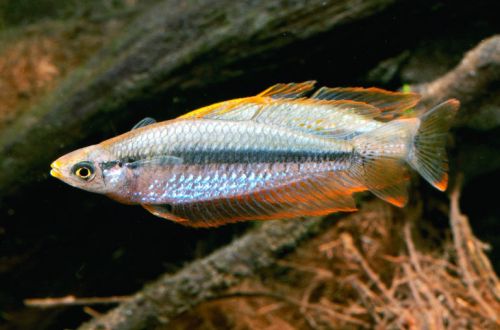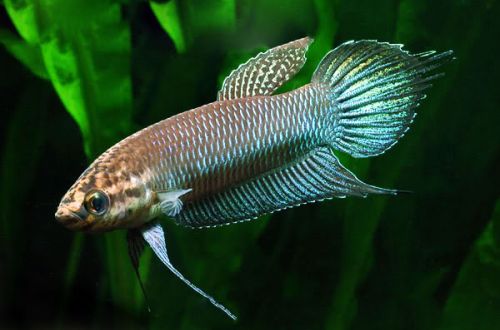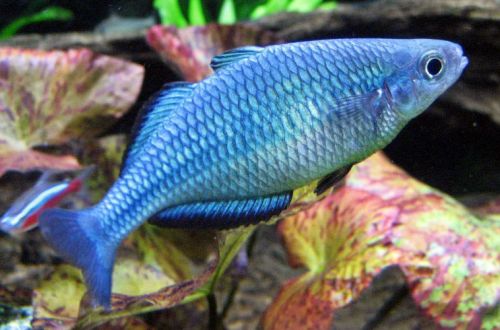
Aphiolebias Peruvian
Aphiolebias Peruvian, scientific name Aphyolebias peruensis, belongs to the family Rivulidae (Rivulaceae). Slender beautiful fish from the virgin rainforests of northern Peru. It lives only about one year, so it is supplied to aquariums in the form of eggs, which have amazing vitality.
Contents
Habitat
The fish is native to South America. As the name implies, the natural habitat is limited to the territory of Peru. They are found in the north of the country in small reservoirs in untouched tropical forests.
The reservoir in which the fish live is a shallow puddle in the forest floor or backwater near the river with a substrate of mud, leaves and branches. The water is muddy.
Such reservoirs are temporary. They form during the rainy season and dry out during the dry season. Accordingly, the life cycle of fish is determined by this time interval.
Description
Adults reach a length of up to 10 cm. The fish have a slender, graceful body and large fins, which are most pronounced in males. This species is distinguished by large eyes, necessary for life in conditions of poor visibility.

Peruvian Aphiolebias has a high intraspecific variability, so fish from different regions can vary greatly in color. However, the predominant colors are grey-yellow and grey-turquoise. The brightest colors are found on the fins and tail. Regardless of the color variation, the fish are characterized by a striped body pattern.
In the wild, these fish live only one season, as long as there is a temporary reservoir. In 7–8 months, they have time to quickly go through all stages of the life cycle, from eggs to mature fish.
In home aquaria with a stable habitat, life expectancy is much longer and reaches an average of 1.5 years.
Behavior and Compatibility
Due to the peculiarities of the natural habitat, the Peruvian Afiolebias, as a rule, lives in the company of relatives. In the wild, living together with other species is rare. Occasionally, other Killy fish can become neighbors.
In a home aquarium, it is permissible to keep with fish of a comparable size that can live in similar conditions.
Brief information:
- The volume of the aquarium – from 50 liters.
- Temperature – 27-30°C
- pH value is about 5.8
- Water hardness – soft (5-8 dGH)
- Substrate type – soft dark
- Lighting – subdued
- Brackish water – no
- Water movement – none
- The size of the fish is about 10 cm.
- Nutrition – any food with a high protein content
- Temperament – peaceful
- Content in a heterosexual group
- Lifespan up to 1.5 years
Features of the maintenance and design of the aquarium

The optimal size of the aquarium for 3-4 fish starts from 40-50 liters. If breeding is not planned, then the design is quite simple. It is recommended to use soft dark soil on which a layer of leaves, branches, snags is placed. It is acceptable to plant shade-loving plants, as well as some vegetation floating on the surface.
The set of equipment consists of a simple airlift filter and a heater. Afiolebias Peruvian prefers subdued lighting levels. For this reason, a separate light source is not required for an aquarium located in a living room.
It is important to maintain low water hardness values and acidic pH values (around 5.3). The comfortable temperature is high and in the range of 27–30°C.
Breeding and reproduction
Given the short lifespan of this species, you can try to start the breeding process to maintain the population of fish in the aquarium.
Stimulation of spawning will not cause difficulties even for a novice aquarist. However, maintaining a viable caviar is a difficult task.
Fish willingly spawn when they reach sexual maturity by 4–5 months. The best result can be achieved if the diet consists of feeds with a high protein content. It can be live or frozen bloodworms, brine shrimp, daphnia, mosquito larvae, etc.
In the wild, fish lay eggs in the thickness of soft ground. When the reservoir dries up, the eggs end up in a dry substrate with low humidity, where they wait for the end of the dry period. A similar process must be carried out in an aquarium.
Thus, decoration is of great importance in the breeding process. The soil plays a key role. As a primer, fibrous soft materials are recommended, preferably natural, such as coconut fiber or a layer of sphagnum.
In anticipation of spawning, it is necessary to regularly clean the soil with a siphon, removing organic waste.
When eggs are seen, the substrate is removed. It is advisable to rinse it a little in the same water from the aquarium, but very carefully so as not to damage the eggs and remove as much organic debris as possible.
The substrate is dried to the state of “slightly wet” and placed in a container with a perforated lid. The container is left in a dark place at a temperature of about 25°C. The duration of incubation is 4 months.
It is recommended to periodically check the substrate for the presence of mold and fungi, removing the affected eggs. You should also control the humidity and, if necessary, moisten it a little.
After 4 months, the substrate with eggs is immersed in water. If everything is done correctly, then the fry appear within a few days.





